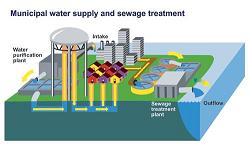

WATER SUPPLY SYSTEMS MANAGEMENT
Water Treatment Supply System
2 Financial Management
It is essential to establish a sound financial management system to make the water supply system financially viable. This can be achieved by controlling expenditure and increasing the income. Control of O&M expenditure can be achieved by preparing an annual budget of income and expenditure of O&M, based on realistic estimates. The estimation of outlays on O&M varies from city to city and it is mainly a function of establishment and power charges for pumping schemes and often lesser or no power charges for gravity supplies. The break up of O&M cost varies from place to place. From the basis of available data the average breakup of O&M cost is likely to be as follows: Power Charges about 30 to 50%, Salaries as high as 36%, Chemicals such as Alum and Chlorine about 3 to 4%, Repairs and replacements about 10 to 15%, debt servicing about 20%, depreciation about 2%. It will be possible to increase the revenue by reviewing water rates in case income is less and revise these in time to cover the losses. The organization shall realize that full cost recovery of O&M cost by user charges is a must. The tariff structure is to be evolved to recover the O&M cost and have a surplus for debt servicing and depreciation. Though everyone shall contribute to the cost, it is still necessary that a survey on the paying capacity of consumers may be required to ensure that tariffs are affordable. It is always prudent to levy the minimum payable charges by the economically weaker section and suggest higher rates to others who can afford. A review of free supplies through public stand-posts may be required. Perhaps the possibility of organized selling of water through public taps can also be studied. It will be necessary to establish a system of raising bills and recoveries to maintain the cash flow and also aim at a larger ratio of collection to billing. Cost recovery can also be achieved by reducing losses by applying better pipe laying and plumbing techniques, undertaking timely preventive maintenance, detecting and reducing losses and controlling illegal connections.
3 Replacement of Equipment
In several installations the equipment might have outlived its life or out of previous neglect or misuse might have deteriorated up to a stage at which replacement of the equipment is absolutely necessary. Fig. 20.8 shows the bath tub curve indicating the useful life of the equipment. After the useful life the wear out increasing drastically and any expenditure for overhauling will be high and replacement will be the best option.
4 Water Audit
There are considerable losses in the water produced and distributed which leads to reduction in the income/revenue of the utility. Some of these losses are physical leakage of water and some are revenue losses. Hence a water audit will be required to be done to get fairly accurate figures of the following – Water production, Water assessed, Losses both Physical and revenue. Water audit could lead to prioritizing actions required to reduce the physical and revenue losses.
5 Energy Audit
Power charges are likely to be as high as 30 to 50% of the total O&M cost. Hence an efficient use of power and reducing wastage of power will go a long way in efficient functioning of the utility. This could be achieved by a systematic energy audit which can identify the possible means to save energy and reduce power consumption.
6 Safety in Operation and Maintenance
Operations in O&M of a Water Supply System also may result in accidents. Hence there is a need for safety practices to be followed by the O&M personnel. Adoption of safe practices and use of safety equipment may largely minimize accidents. Many accidents occur due to the human factor. Though the ultimate responsibility may be that of management, the operator cannot also be relieved of his responsibility. Hence a safety program is to be written down for every organization and it must be ensured that every one in the organization scrupulously follows the safety practices.
7 Public/Private Partnership
Improving the efficiency of O&M depends to a great extent on the proper functioning of flow meters and instrumentation in alum coagulation, chlorination etc. However, it is not always possible to find and employ personnel with specialized skills for the maintenance of flow meters, other instrumentation in water treatment plants and pumping installations, chlorination plants and alum dosers. Instead of trying to recruit additional staff for repairs and maintenance of the specialized equipment, it is always a better alternative to obtain on contract, the specialized services for maintenance of the above mentioned equipment. Such a practice may ensure proper functioning of the equipment with least cost.
4 Responses to “WATER SUPPLY SYSTEMS MANAGEMENT”
Leave a Reply







 LIKE TO GET UPDATES
LIKE TO GET UPDATES  TO GET EXPERT GUIDE
TO GET EXPERT GUIDE
Looking forward to reading more. Great article post.Much thanks again. Want more.
Thank’s for This Good Read ….
Enjoyed reading this posting, good of you for discussing.
Good article water management and water supply. Thank you.